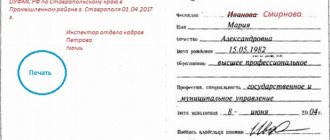What is the nomenclature of personnel service affairs?
The HR department of any modern company processes a huge number of different documents: local regulations, cards, work books, contracts.
And of course, for their effective recording, systematization of document flow is necessary. But even if a company is theoretically satisfied with managing the circulation of personnel documents outside of a systematic approach, in certain cases it will have to systematize it based on legal requirements.
The fact is that in accordance with paragraph 1 of Art. 17 of the Law “On Archival Affairs” dated October 22, 2004 No. 125-FZ, organizations must ensure the safety of documents classified as archival (subject to preservation due to their significance for the owner). These include almost all documentation used in personnel document flow. The safety of archival documents must be ensured by the employing company within the time limits established by law.
You will learn more about the periods established by law for storing archival documents in the article “What are the storage periods for documents according to the nomenclature of files?” .
At the same time, the method of fulfilling the requirements of Law No. 125-FZ depends on whether the organization is public or private:
- When optimizing document flow, government agencies must follow the rules established by the decision of the Rosarkhiv board of 02/06/2002 (hereinafter referred to as the Rosarkhiv rules).
- In general, private companies are not subject to this legal regulation (only if they use government documents). But in practice, many private firms still follow the relevant rules. This is due to the fact that the norms contained in them regulate in great detail and effectively the organization of document flow, the main element of which is precisely the nomenclature of cases.
What is she like? If we follow the definition of Rosarkhiv, the nomenclature of cases must be understood as a list of names of cases compiled in the established form, formed in the process of the organization’s document flow. In this case, affairs are understood as a category of documents of the same type used in the turnover of the company. If we talk about personnel services, these could be:
- orders;
- contracts;
- accounting documents;
- cards;
- work books, etc.
In accordance with the requirements of the Federal Archive, the nomenclature must indicate the storage periods for files. This allows the company to monitor whether the legal security of documents is ensured within the established time frames.
The nomenclature can also record other information used to improve the efficiency of document flow (for example, indexes of cases, the number of their volumes, service marks and notes). This is the benefit of nomenclature from the point of view of systematizing document management.
What is the nomenclature of HR department affairs?
The larger the company, the higher the document flow in the HR department.
But even in small organizations, already at the stage of hiring a new employee, he is required to have a certain set of documents forming a personal file. Again, the longer a company operates, the more documents accumulate that are subject to long-term storage. This entire array of documentation can simply be sorted into folders (and this is already a system, albeit still informal). But to make it easier to navigate, a table of contents, a list, and a brief description are compiled. A qualified personnel employee compiles a list of cases. This approach, on the one hand, characterizes the employee as a professional, on the other hand, it facilitates document flow in the company, and therefore the work of this employee.
The legislation provides the following definition of the nomenclature of cases - this is a systematized list of names of cases, which has an approved form. The nomenclature of cases in the personnel department is, accordingly, a list of cases passing through the department.
Systematization facilitates the process of collecting documents, arranging them for storage and, of course, finding the necessary papers. Having a nomenclature makes it easier for a new HR employee to get up to speed. After the company is closed, thanks to the presence of the nomenclature, you can quickly separate the documents that need to be deposited from the rest of the mass and carry out the transfer itself.
Such a number of advantages of maintaining a list of cases in the personnel department has allowed this practice to spread among private companies for which this obligation is not provided for at the legislative level. As for the disadvantages, they appear only in cases where the company has already accumulated a lot of documents, and they need to be systematized, and this may require a large number of labor hours, and sometimes even workdays.
Ensuring the safety of documents: how the nomenclature can help
Ensuring the safety of personnel documents within the time limits established by law is one of the key tasks of a personnel officer. And the use of nomenclature can help solve it.
In order to store documents for a specified period, the personnel officer needs to determine this period (for each case) and compare it with the types of documents used.
The main regulatory legal acts that establish the storage periods for personnel documents can be called:
- list of standard documents approved by order of the Federal Archive of the Russian Federation dated December 20, 2019 No. 236;
- list of standard documents approved by the USSR Main Archive on August 15, 1988.
In particular, the rules establishing the storage periods for personnel documentation are contained in section 8 of the list approved by order No. 236, as well as section 6 of the list introduced by the USSR Main Archive.
The next task of the personnel officer is to conduct an examination of the value of the sources used in document flow. This procedure identifies documents that:
- must be archived for long-term storage;
- can be transferred for operational storage, and after the expiration of the period of their placement in the organization, they can be destroyed in the prescribed manner;
- may no longer be stored in the organization due to the expiration of their storage period (or due to the fact that they do not represent value for the company) and must be destroyed.
The HR officer will be able to successfully solve the problem under consideration precisely thanks to the nomenclature of cases, since its structure includes all the necessary information:
- lists of categories of documents whose safety must be ensured;
- their storage periods stipulated by law.
Sample list of affairs of the HR department
Organization is a complex mechanism. For coordinated work, it is necessary not only to debug production or other processes, but also to systematize document flow.
The latter exists in order not to get confused in affairs and actions. For each division, for example, for the personnel department, a range of cases is defined that are under its jurisdiction.
Dear readers! Our articles talk about typical ways to resolve legal issues, but each case is unique.
If you want to find out how to solve your particular problem, contact the online consultant on the right or call the free consultation numbers:
Why does an organization need a list of cases?
When conducting document flow, specialists, in our case the HR department, are guided by the following legislative norms :
- By Order of the Main Archive No. 33 (May 23, 1988), issued back in the USSR. This document puts into effect the basic rules of document flow and document management.
- By decision of Rosarkhiv (February 6, 2002).
- Rules of office work (Government Decree “On approval of rules of office work in federal executive bodies” No. 477, 2009, June 15).
The nomenclature of personnel service files is a directory of archival files of employees and other personnel-related materials: when hired, when fired, salary, movement within the organization, etc.
In addition, an employee may request archival information during work and after dismissal, so there is a period for storing materials or files.
Read more about the nomenclature of the organization’s affairs in our article.
The necessary documents are contained in the department. The remaining materials are sent to the archive. Nomenclature allows you to organize things and systematize them. Its features:
- Easy to search.
- Indexing of stored documents.
- Established shelf life for materials.
- Accounting for documents that are stored for less than 10 years.
- Accounting and inventory of those stored for over 10 years.
- The destruction of documents whose storage has been terminated has expired.
- Drawing up acts for their destruction.
The materials, as well as the cases involved in the document flow, each have their own names. A systematic list of them is called nomenclature. It is drawn up in the prescribed form.
three types of nomenclature :
- Typical. Mandatory for organizations of the same type. Approved by law or department for subordinate structures.
- Approximate – recommendation for certain enterprises and organizations.
- Individual. It is created for a specific organization and approved by it. It may contain two subtypes: for a department and a consolidated one, i.e. created on the basis of the nomenclatures of all departments.
Nomenclatures of departments
Each department of the organization maintains its own list of cases. Each department has different affairs, and accordingly, the nomenclatures are different . Let us consider, as an example, samples of nomenclatures for several departments of an organization.
Accounting
The nomenclature of this department includes all documents related to accounting and tax reporting, including insurance premiums. It includes internal accounting documents and outgoing documents, such as tax reports. The list also includes incoming documents, paid bills, and the like.
If the accounting department is also entrusted with the functions of the personnel department, then personnel documents are also included in the nomenclature.
Legal
The list includes all legal documents related to the activities of the enterprise. It is mandatory to contain federal legislative acts, normative documents, resolutions of regional bodies, the charter of the organization, power of attorney journals, acts of acceptance and transfer of the position of head of the unit.
The main feature of this nomenclature is that it is not transferred to departmental or state archives for storage.
It is stored permanently in the organization until its activities cease. For documents included in the list, a storage period of up to 5 years . At the same time, federal acts are written off when they lose their force, local ones - after a year, internal ones - from the moment of termination within five years.
This provision depends on the category of documents. For example, legal correspondence is stored for 3 years, and contracts with organizations - 5.
Human Resources Department
The nomenclature of the personnel service includes documents and materials relating to the personnel and employees of the organization :
- Compiled by the personnel officer.
- Received from management, related departments, and personnel.
- Personnel records, forms that are provided for working with personnel.
The main list of documents includes:
The list is not complete. But a basis for creating a nomenclature . Depending on the specifics of the activity and the organizational form, the list may be supplemented or changed. For example, if a collective agreement was not adopted and personal affairs are not maintained, then these documents may not be included in the list.
However, there are general rules that must be followed:
The original is included in the consolidated nomenclature of the organization. It is best to separate this document (a copy of the staffing table) into a separate file. Materials related to changes in the state will be filed here.
The main feature of the personnel nomenclature, it seems to us, is the shelf life of materials and documents. The minimum period is established for documents that have become unnecessary, the need for them has expired. It is at least 1 year.
Documents important for the organization and the department itself are stored until the organization is liquidated.
This is an agreement between the administration and the staff, regulations on the personnel department and a number of others. The maximum shelf life is set at 75 years . It is valid for personnel documents: employment contracts, personnel records, personal files. After liquidation, materials subject to long-term storage are transferred to departmental or state archives.
How to compose it correctly?
The organization draws up a list of to-dos individually. If a standard nomenclature , then the name of the cases is transferred from the established form to its list.
When forming the nomenclature, the specifics of the organization, its structure, and activities are taken into account. If the organization has structural divisions, then first their own lists are created within departments or divisions, then they are consolidated into a single nomenclature for the entire organization.
For development, you can involve either a third-party organization, for example, an archive, or entrust it to your employees or department. For this purpose, management issues an order to develop the nomenclature of the enterprise, with the appointment of responsible persons.
The list must include:
- Articles of association.
- Regulations on structural divisions. If they are.
- Nomenclature of departments' affairs.
- Staffing schedule.
- Regulatory acts regulating the activities of the organization.
- Job descriptions.
After an analysis of the lists of cases from previous years unfinished cases and documents in storage can be included in the nomenclature (if the storage period is over 10 years, then it is mandatory).
The rules establish the form of nomenclature. It is compiled in the form of a table. For the consolidated nomenclature of the (main) organization, 7 appendix of the Rules for the operation of archives. For departments – 8 appendix.
The table consists of 5 columns (graph):
- Case number (index).
- Its name.
- Number of folders (storage units) in the file.
- Case retention period.
The information in this column may vary. For example, a message that the case is stored electronically or transferred to a higher organization.
Procedure for drawing up and approval
The first step is to analyze all documents, previous lists, documents that have arisen in the process of activity, the Charter, the collective agreement, the staffing table, regulations and other significant materials.
If the organization has divisions, then first they create their nomenclatures. These documents are then agreed upon by an expert commission (EC) or its own archival service .
After this, a consolidated nomenclature . It is also consistent with the EC and archive specialists.
The agreed list is approved by management and put into effect by order .
Learn the nuances of the HR department nomenclature from the video:
Didn't find the answer to your question? Find out how to solve exactly your problem - call right now:
It's fast and free!
We also recommend reading:
Source: https://artansk.ru/obrazets-nomenklatury-del-otdela-kadrov/
The nuances of compiling a nomenclature of personnel service affairs
We noted above that the rules of Rosarkhiv are in demand by private firms, although they are not mandatory for them. When compiling a list of cases, a personnel officer of a commercial organization may well rely on the standards approved by this department.
Thus, Rosarkhiv instructs government agencies (and actually recommends private firms) to draw up a nomenclature for the coming year. Preferably at the end of the current year, in order to put it into effect on January 1 of the next year. In turn, at the end of next year a new nomenclature needs to be approved. And so every year.
Let's see how this happens in practice. Let's agree that the company has just been founded and does not have a current nomenclature. What might be the algorithm of actions of a personnel officer to approve the list of cases in a newly formed organization?
The personnel officer needs to immediately prepare for the preparation of the future nomenclature immediately after starting work. This direction of his activity involves solving 2 main tasks:
- classification of documents used in circulation into categories, that is, the formation of cases;
- determination of storage periods for cases in accordance with the regulations specified above.
If the storage periods for a specific category of documents are not specified in Order No. 558, you should check whether they are recorded in the list of the Main Archive of the USSR. This sequence of reference to legal acts is due to the fact that the first source of law is newer and, in accordance with generally accepted legal practice, it should be applied first.
If none of the lists approved by law define the storage periods for certain files, you should consult on this matter (by making an official request) with the Federal Archive. It is not recommended to independently determine the storage period for documents.
As this work is carried out, the specialist must record the types of cases identified, as well as the periods for their storage provided by law in a special document. In fact, it will be the prototype of the future nomenclature, and therefore may completely coincide with it in structure.
The HR department is a structural unit of the organization. So the nomenclature of cases (and before it, a temporary document in which cases are classified) can be compiled according to the form from Appendix 8 to the rules of the Federal Archive, intended for registration of the nomenclature of cases in a particular structural unit of the company.
The main element of the form according to Appendix 8 is a table that reflects:
- case index;
- case title;
- number of storage units;
- storage periods and numbers of articles according to the list;
- notes on nomenclature.
Let's study the specifics of each of the columns of the table of the recommended form of nomenclature in more detail.
Form for compiling a nomenclature of personnel service cases
For the nomenclature of files, a special form is provided, given in the rules for the operation of archives of organizations (decision of the Federal Archives of 02/06/2002).
Document preparation includes:
- full and abbreviated name of the organization;
- title “Nomenclature of cases for the year XXXX”;
- Date of preparation;
- dated executive visa approval;
- at the end - the names and signatures of the compiler (clerk, archivist) and the necessary approvals.
The content part is a table with 5 columns:
| No. | Name | Content |
| 1 | Index | office work index, including the code of the department in which the folder was created and its serial number |
| 2 | Heading | The headings of sections within the file are arranged depending on the importance of the documents included in them: organizational and administrative, planning and reporting, others, in order of decreasing storage periods |
| 3 | Number of storage units | the number of folders and volumes in it is indicated; filled out at the end of the year, when all cases have been formed and their volume is precisely known. |
| 4 | Storage period with numbers of articles of the regulatory list | The period of mandatory storage of the file is indicated in accordance with the List of standard management documents approved by the Ministry of Culture, with reference to the article number |
| 5 | Note | the necessary notes are made: about the destruction of files, transfer to the archive, etc. |
Structure of the nomenclature of the HR department
The structure of the nomenclature of affairs of the HR department in accordance with Appendix 8 to the rules of the Federal Archive is as follows:
- In the 1st column of the table, case indices are recorded. Typically they reflect:
- with which structural unit or area of activity of the company does this or that matter correlate?
- which serial number corresponds to a specific case.
- For example, if the index 01–02 is recorded in the nomenclature, this may mean that the case was compiled in division 01 (conditionally it can correspond to the personnel department) and is a group of documents of type 02 (conditionally they can correspond to fixed-term employment contracts).
- The 2nd column of the nomenclature in the form of Appendix 8 is the headings of the cases. The names of specific categories of documents or cases (orders, contracts, personal cards, etc.) are indicated here.
- The 3rd column of the nomenclature records the number of specific types of cases stored in the company. This column is filled in at the end of the calendar year, when the personnel officer will know exactly the number of cases recorded by the company.
- The 4th column records the storage period for each category of documents, and also provides links to articles of regulatory legal acts in which these periods are defined.
- In the 5th column, notes may be made regarding the use of documents related to a particular case. For example, reflecting the fact of seizure or destruction of certain documents.
Having generated a list of categories of personnel matters by the end of the year, the specialist can begin to officially approve this list in the form of a nomenclature of matters that will be used from January 1 of the next year.
Nomenclatures of departments
Each department of the organization maintains its own list of cases. Each department has different affairs, and accordingly, the nomenclatures are different . Let us consider, as an example, samples of nomenclatures for several departments of an organization.
Accounting
The nomenclature of this department includes all documents related to accounting and tax reporting, including insurance premiums. It includes internal accounting documents and outgoing documents, such as tax reports. The list also includes incoming documents, paid bills, and the like.
If the accounting department is also entrusted with the functions of the personnel department, then personnel documents are also included in the nomenclature.
Legal
The list includes all legal documents related to the activities of the enterprise. It is mandatory to contain federal legislative acts, normative documents, resolutions of regional bodies, the charter of the organization, power of attorney journals, acts of acceptance and transfer of the position of head of the unit.
The main feature of this nomenclature is that it is not transferred to departmental or state archives for storage.
It is stored permanently in the organization until its activities cease. For documents included in the list, a storage period of up to 5 years . At the same time, federal acts are written off when they lose their force, local ones - after a year, internal ones - from the moment of termination within five years.
This provision depends on the category of documents. For example, legal correspondence is stored for 3 years, and contracts with organizations - 5.
Human Resources Department
The nomenclature of the personnel service includes documents and materials relating to the personnel and employees of the organization :
- Compiled by the personnel officer.
- Received from management, related departments, and personnel.
- Personnel records, forms that are provided for working with personnel.
The main list of documents includes:
The list is not complete. But a basis for creating a nomenclature . Depending on the specifics of the activity and the organizational form, the list may be supplemented or changed. For example, if a collective agreement was not adopted and personal affairs are not maintained, then these documents may not be included in the list.
However, there are general rules that must be followed:
Read more: How to calculate the useful life of a building
The original is included in the consolidated nomenclature of the organization. It is best to separate this document (a copy of the staffing table) into a separate file. Materials related to changes in the state will be filed here.
The main feature of the personnel nomenclature, it seems to us, is the shelf life of materials and documents. The minimum period is established for documents that have become unnecessary, the need for them has expired. It is at least 1 year.
Documents important for the organization and the department itself are stored until the organization is liquidated.
This is an agreement between the administration and the staff, regulations on the personnel department and a number of others. The maximum shelf life is set at 75 years . It is valid for personnel documents: employment contracts, personnel records, personal files. After liquidation, materials subject to long-term storage are transferred to departmental or state archives.
Approval of the nomenclature of personnel service cases
The nomenclature of the personnel department (a structural unit of the company) should be part of the consolidated nomenclature compiled for the organization as a whole. The consolidated nomenclature, in turn, can be formed on the basis of the form given in Appendix 7 to the rules of the Federal Archive.
Its structure almost completely coincides with that contained in Appendix 8. The table of this form contains the same columns as in the nomenclature for the structural unit.
The use and approval of a consolidated nomenclature in government agencies is an indispensable condition for legitimizing the nomenclature of departments (including the personnel service).
Let us agree that our private company also uses the rules of Rosarkhiv from the point of view of using the consolidated nomenclature.
If a private company decides to ensure maximum compliance of the nomenclature approval procedure with the standards set out in the rules of the Federal Archive, the procedure will be as follows.
The HR manager will need:
- finally formulate your nomenclature, carefully check the information reflected in the temporary accounting document according to the form from Appendix 8, and correct them if necessary;
- coordinate the formed nomenclature with the employee responsible for maintaining the archive (most likely, this will be the company’s document specialist), as well as the head of the personnel department;
- wait until the nomenclatures of other divisions of the company are agreed upon in a similar way.
The specialist responsible for compiling the consolidated nomenclature should:
- collect all the nomenclatures approved at the level of the company’s divisions, and then create, based on the data available in them, a consolidated nomenclature in the form approved in Appendix 7 to the rules of the Federal Archive;
- agree on the consolidated nomenclature with the document specialist;
- approve the consolidated nomenclature from the head of the company.
Coordination or approval of nomenclatures (personnel, other departments, consolidated) can be carried out by affixing the signatures of competent persons on them. But if approval of the document by the manager is required, it is better if a separate order is issued.
In government agencies, the consolidated nomenclature is consistent with departmental and internal expert commissions. In private companies, as a rule, there are no such divisions, so the text blocks of the form where the signatures of the certifying persons are placed can be modified by inserting blocks for approval by specific officials.
Features of the nomenclature of personnel service affairs
Important! Each enterprise keeps records of personnel records based on its personal practice.
However, among HR employees there are several rules that will help to significantly simplify the work, as well as filling out the nomenclature:
- Employment agreements can be stored either separately or as part of personal files. In the 1st case, the information is entered as a separate line in the nomenclature under the name “Employment contracts”; in the 2nd case, the information is entered under the name “Personal files”.
- Additional agreements are not recorded separately, since they are an integral part of the contract.
- In enterprises with a large number of employees, it is permissible to systematize employment contracts by last name according to the alphabet.
- The contracts of dismissed persons are subject to withdrawal from the file. From them a new album is formed with invalid contracts.
- Personal cards are the main accounting document and therefore must be stored separately. Accordingly, they should be included in the nomenclature in the form of a separate array.
- Personal cards of dismissed persons are also subject to transfer to the “Personal cards of dismissed employees” file.
- Orders for personnel must be distributed strictly depending on their storage period: 75/50 or 5 years.
- It is most convenient to separate the staffing table, as well as all its changes, into a separate complex, but it is worth understanding that a copy of it will be taken into account in this complex (the staffing table is an appendix to the order for the main activity, which means that its original must be stored and taken into account in this array of nomenclature).
You will find many detailed explanations about the approval of the list of cases in the organization in ConsultantPlus. If you do not yet have access to the ConsultantPlus system, you can sign up for a free trial access for 2 days.
Results
The nomenclature of affairs of the HR department of an enterprise is a tool, the use of which, on the one hand, is necessary in order for the company to fulfill its statutory obligations, and on the other hand, it can significantly increase the efficiency of document flow.
The nomenclature for the coming year should be approved taking into account changes in the structure of cases occurring in the current year.
You can learn more about the specifics of compiling and using a list of cases in an enterprise from the article “How to create a list of cases in an organization?” .
You can find more complete information on the topic in ConsultantPlus. Free trial access to the system for 2 days.







